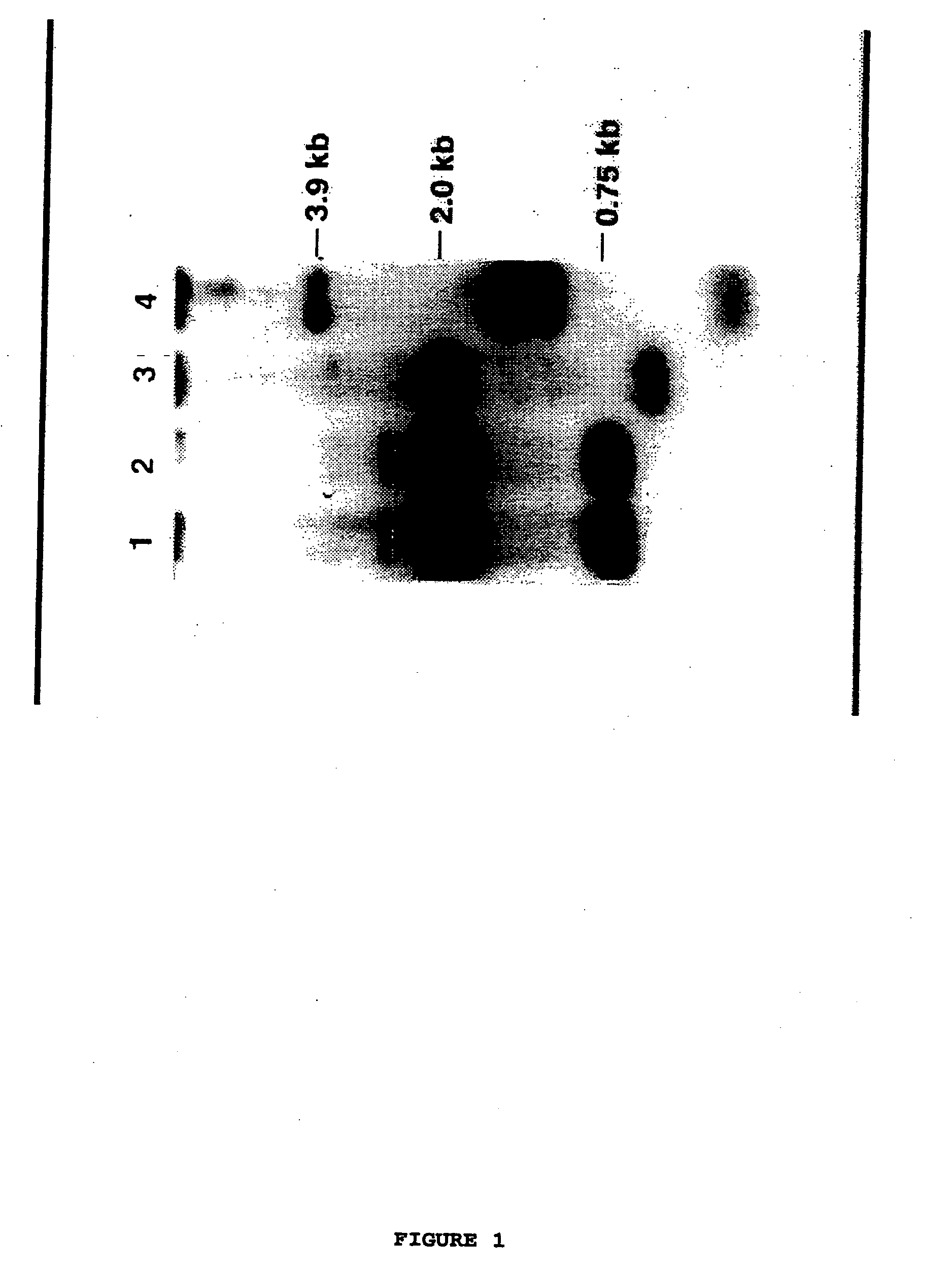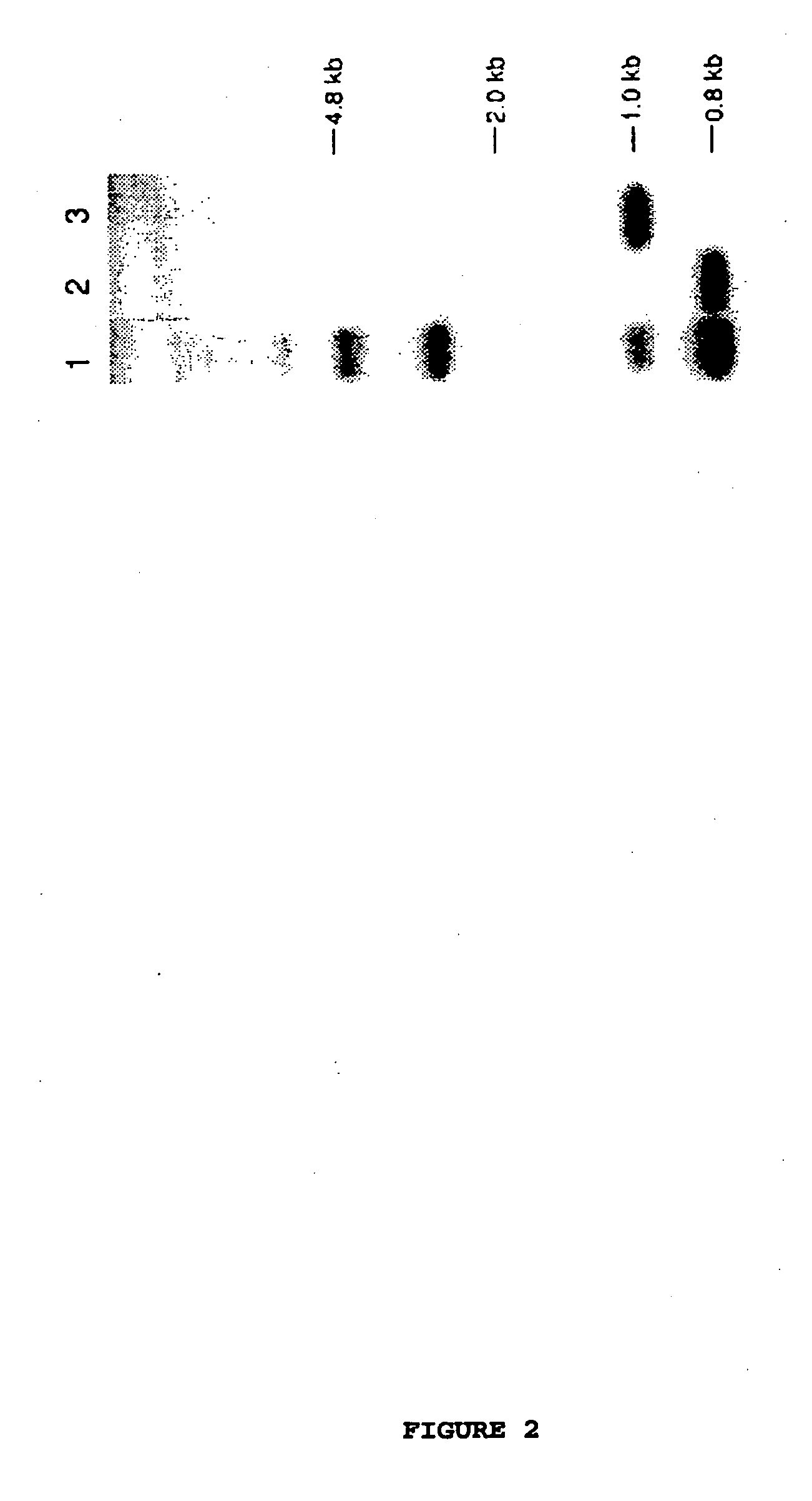Regulation of gene expression in plants
a technology of gene expression and plant, applied in the field of plant gene expression regulation, can solve the problems of major problems, inability to find corresponding full-length cdna sequences for wheat, and inability to modify wheat by combination of null alleles of several enzymes in general, and achieve the effect of suppressing expression
- Summary
- Abstract
- Description
- Claims
- Application Information
AI Technical Summary
Benefits of technology
Problems solved by technology
Method used
Image
Examples
example 2
Frequency of Recovery of SBE I Type Clones from the Genomic Library
[0125] An estimated 2×106 plaques from the amplified library were screened using an EcoRI fragment that contained 1200 bp at the 5′ end of maize SBE I (Baba et al, 1991) and twelve independent isolates were recovered and purified. This corresponds to the screening of somewhat fewer than the 2×106 primary plaques that exist in the original library (each of which has an average insert size of 15 kb) (Maniatis et al, 1982), because the amplification may lead to the representation of some sequences more than others. Assuming that the amplified library contains approximately three genomes of T. tauschii, the frequency with which SBE I-positive clones were recovered suggests the existence of about 5 copies of SBE I type genes within the T. tauschii genome.
[0126] Digestion of DNA from the twelve independent isolates by the restriction endonuclease BamHI followed by hybridisation with a maize SBE I clone, suggested that th...
example 3
Tandem Arrangement of SBE I Type Genes in the T. tauschii Genome
[0129] Basic restriction endonuclease maps for λE1 and λE7 are shown in FIG. 3. The map was constructed by performing a series of hybridisations of EcoRI or BamHI digested DNA from λE1 or λE7. The probes used were the fragments generated from BamHI digestion of the relevant clone. Confirmation of the maps was obtained by PCR analysis, using primers both within the insert and also from the arms of lambda itself. PCR was performed in 10 λl volume using reagents supplied by Perkin-Elmer. The primers were used at a concentration of 20 λM. The program used was 94° C., 2 min, 1 cycle, then 94° C., 30 sec; 55° C., 30 sec; 72° C., 1 min for 36 cycles and then 72° C., 5 min; 25° C., 1 min.
[0130] Sequencing was performed on an ABI sequencer using the manufacturer's recommended protocols for both dye primer and dye terminator technologies. Deletions were carried out using the Erase-a-base kit from Promega.
[0131] Sequence analys...
example 4
Construction and Screening of cDNA Library
[0133] A wheat cDNA library was constructed from the cultivar Rosella using pooled RNA from endosperm at 8, 12, 18 and 20 days after anthesis.
[0134] The cDNA library was prepared from poly A+ RNA that was extracted from developing wheat grains (cv. Rosella, a hexaploid soft wheat cultivar) at 8, 12, 15, 18, 21 and 30 days after anthesis. The RNA was pooled and used to synthesise cDNA that was propagated in lambda ZapII (Stratagene).
[0135] The library was screened with a genomic fragment from λE7 encompassing exons 3, 4 and 5 (fragment E7.8 in FIG. 3). A number of clones were isolated. Of these an apparently full-length clone appeared to encode an unusual type of cDNA for SBE I. This cDNA has been termed SBE I-D2 type cDNA. The putative protein product is compared with the maize SBE I and rice SBE I type deduced amino acid sequences in FIG. 4. The main difference is that this putative protein product is shorter at the C-terminal end, with ...
PUM
| Property | Measurement | Unit |
|---|---|---|
| nucleic acid | aaaaa | aaaaa |
| nucleic acid construct | aaaaa | aaaaa |
| time | aaaaa | aaaaa |
Abstract
Description
Claims
Application Information
 Login to View More
Login to View More - R&D
- Intellectual Property
- Life Sciences
- Materials
- Tech Scout
- Unparalleled Data Quality
- Higher Quality Content
- 60% Fewer Hallucinations
Browse by: Latest US Patents, China's latest patents, Technical Efficacy Thesaurus, Application Domain, Technology Topic, Popular Technical Reports.
© 2025 PatSnap. All rights reserved.Legal|Privacy policy|Modern Slavery Act Transparency Statement|Sitemap|About US| Contact US: help@patsnap.com



